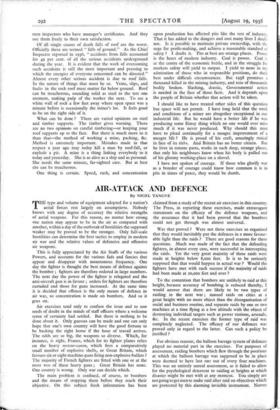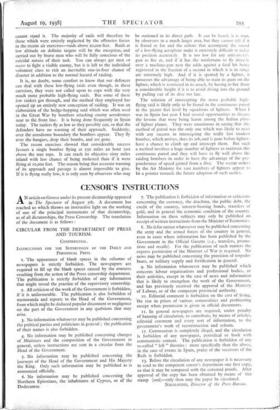AIR-ATTACK AND DEFENCE
By NIGEL TANGYE
THE type and volume of equipment adopted for a nation's aerial forces rest largely on assumptions. Nobody knows with any degree of accuracy the relative strengths of aerial weapons. For this reason, no matter how strong one nation may appear to be in the air as compared with another, within a day of the outbreak of hostilities the supposed weaker may be proved to be the stronger. Only full-scale hostilities can determine the best tactics to employ in modem air war and the relative values of defensive and offensive air weapons.
This is fully appreciated by the Air Staffs of the various Powers, and accounts for the various fads and fancies that appear and disappear with monotonous frequency. One day the fighter is thought the best means of defence against the bomber ; fighters are therefore ordered in large numbers. The next day the power of the fighter is relegated and the anti-aircraft gun is in favour ; orders for fighters are therefore curtailed and those for guns increased. At the same time it is decided that offence is the only means of defence in air war, so concentration is made on bombers. And so it goes on.
Air exercises tend only to confuse the issue and to sow seeds of doubt in the minds of staff officers where a welcome sense of certainty had settled. But there is nothing to be done about it. Only guesses can be made and one can only hope that one's own country will have the good fortune to be backing the right horse if the hour of travail arrives. The odds are so big, the weapons so diverse. Which, for instance, is right, France, which for its fighter planes relies on the heavy moteur-canon, which fires a comparatively small number of explosive shells, or Great Britain, which favours six or eight machine-guns firing non-explosive bullets ? The majority of French fighters are fitted with one or at the most two of these heavy guns ; Great Britain has none. One country is wrong. Only war can decide which.
The main problem is confined, of course, to bombers and the means of stopping them before they reach their objective. On this subject fresh information has been claimed from a study of the recent air exercises in this country. The Press, in reporting these exercises, made extravagant statements on the efficacy of the' defence weapons, and the assurance that it had been proved that the bombers could not get through was almost universal. , Was that proved ? Were not these exercises so organised that they would inevitably put the defences in a more favour- able light than the raids ? There are good reasons for these questions. Much was made of the fact that the defending fighters, in almost every case, were successful in intercepting the raids. Yet the very great majority of these raids were made at heights below 8,000 feet. Is it to be seriously supposed that that would happen in actual war ? Would the fighters have met with such success if the majority of raids had been made at zo,000 feet and over ?
To the contention that bombers are unlikely to raid at this height, because accuracy of bombing is reduced thereby, I would answer that there are likely to be two types of raiding in the next war ; massed raids on cities at a great height vtith no more object than the disorganisation of social and business routine, and separate raids by one or two machines at a time flying at a low altitude with the object of destroying individual targets such as power stations, arsenals, &c. In the recent exercises the former type of raid was completely neglected. The efficacy of our defences was proved only in regard to the latter. Can such a policy be justified ?
For obvious reasons, the balloon barrage system of defences played no material part in the exercises. For purposes of assessment, raiding bombers which flew through the positions at which the balloon barrage was supposed to be in place were deemed to have lost one out of every four machines. This was an entirely unreal assessment, as it failed to allow for the psychological deterrent to raiding at heights at which disaster might be met with at any moment. You simply are not going to get men to make raid after raid on objectives which are protected by this alarming invisible instrument. Nerves cannot stand it. The majority of raids will therefore be those which were entirely neglected by the offensive forces in the recent air exercises—raids above 20,000 feet. Raids at low altitude on definite targets will be The exception, and carried out by brave men who will be fully conscious of the suicidal nature of their task. You can always get men en masse .to fight a visible enemy, but it is left to the individual volunteer class to risk an inevitable one-in-four chance of disaster in addition to the normal hazard of raiding.
It is,, no doubt, some comfort to know that our defences can deal, with these low-flying raids even though, in these exercises,, they were not called upon to cope with the very much more probable high-flying raids. But some of these low raiders got through, and the method they employed has opened up an entirely new conception of raiding. It was an elaboration of the hedge-hopping raid which was often used in the Great War by bombers attacking enemy aerodromes near to the front line. It is being done frequently in Spain today. The raiders fly as low as they possibly can, so that the defenders have no warning of their approach. Suddenly, over the' aerodrome boundary the bombers appear. They fly over the hangars, drop their bombs, and are gone.
The recent exercises showed that considerable success favour's a single bomber flying at 25o miles an hour just above the tree tops. It can reach its objective sixty miles inland with less chance of being molested than if it were flying at io,000 feet. The reason being that accurate warning of its approach and passage is almost impossible to give. If it is flying really low, it is only seen by observers who may be stationed in its direct path. It can be heard, it is true, by observers in a much larger area, but they cannot tell if it is friend or foe and the echoes that accompany the sound of a low-flying aeroplane make it extremely difficult to jude its position accurately. It is too low for any anti-airera gun to fire at, and if it has the misfortune to fly directly over a machine-gun nest the odds against a fatal hit being registered in the fraction of a second in which it is in range are extremely high. And if it is spotted by a fighter, it possesses the advantage of being able to train its guns on the fighter, which is restricted in its attack, by having to fire from a considerable height if it is to avoid diving into the ground by pulling out of its dive too late.
The solution of intercepting the more probable high- flying raid is likely only to be found in the continuous patrol in the 30,000 feet level by squadrons of fighters. When I was in Spain last year I had several opportunities to discuss the lessons that were being learnt among the Italian pilots of fighter planes. They were unanimous in saying that this method of patrol was the only one which was likely to meet with any success in intercepting the really fast modern bomber, which arrives, does its job, and is gone before fighter; have a chance to climb up and intercept them. But such a method involves a huge number of fighters to maintain this continuous patrol and they will have to fly well above the raiding bombers in order to have the advantage of the pre- ponderance of speed gained from a dive. The recent orders by the Air Ministry for vast numbers of fighters appear to be a pointer towards the future adoption of such tactics.







































 Previous page
Previous page